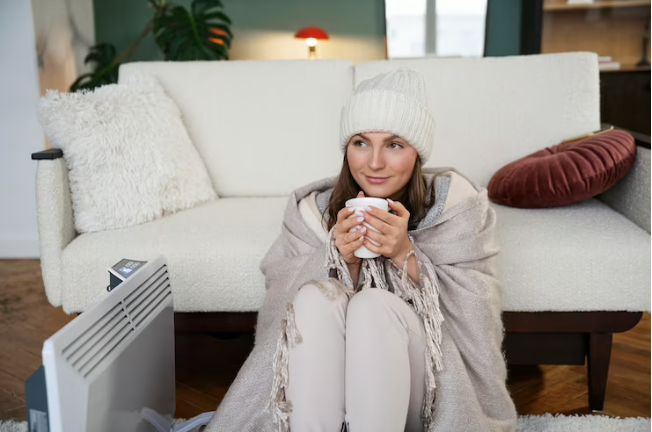Are you ready for winter? As the temperature drops and the snow starts to fall, it’s important to prepare your home for the cold weather.
Winterizing your home can not only keep you warm and comfortable during the winter months, but it can also save you money on energy bills and prevent costly repairs.
In this article, we’ll cover essential repairs you can make to prepare your home for the winter. From checking and improving insulation to preventing pipe freezing, we’ll provide you with practical tips and advice to ensure that your home is ready for the cold weather.
By taking the time to winterize your home, you can enjoy a cozy and comfortable winter season without worrying about unexpected issues or costs.

Checking and Improving Insulation
To ensure your abode is adequately prepared for chilly temperatures, take a moment to examine and enhance the insulation.
Start by checking the type of insulation you currently have. There are different types of insulation, such as fiberglass batts, spray foam, and cellulose, each with their own R-value, or thermal resistance. If your insulation has an R-value of less than 30, it might be worth upgrading to a higher R-value to increase energy efficiency and save on heating costs.
If you’re handy with DIY projects, you can install insulation yourself. However, be sure to follow safety precautions, wear protective gear, and properly seal any gaps or cracks. It’s also important to ensure proper ventilation in the attic or crawl space to prevent moisture buildup.
If you’re not confident in your DIY skills, consider hiring a professional to install the insulation for you.
By checking and improving your insulation, you can keep your home warm and cozy during the cold winter months.
Maintaining Heating Systems
You can’t afford to ignore your heating system this season, or you’ll freeze like a popsicle! As the temperatures drop, it’s crucial to keep your heating system well-maintained and running smoothly to ensure that the warmth keeps flowing throughout your home.
One important step in maintaining your heating system is upgrading your thermostats. Modern thermostats come with advanced features that allow you to control the temperature more efficiently, saving you energy and money in the long run. Some even have smart technology that learns your preferences and adjusts the temperature accordingly.
Another important step in maintaining your heating system is scheduling professional maintenance. A professional technician can inspect your heating system, identify any issues, and fix them before they become bigger problems. They can also clean and tune up your system, ensuring that it is running at optimal efficiency.
Regular maintenance can prolong the lifespan of your heating system, prevent breakdowns, and save you from costly repairs down the line. So don’t wait until your heating system breaks down in the middle of a cold winter night – schedule professional maintenance today and keep your home warm and cozy all season long.
Sealing Gaps and Cracks
Sealing gaps and cracks is a fundamental aspect of maintaining a warm and comfortable indoor environment during chilly months. Weatherstripping windows can help prevent drafts and heat loss, which can result in significant energy savings.
It is important to inspect windows for gaps or cracks and replace any damaged weatherstripping. There are many types of weatherstripping available, such as adhesive-backed foam tape or V-strip, which can be easily installed with a pair of scissors and a utility knife.
Caulking doors is another way to prevent drafts and ensure that warm air stays inside your home. Check the door frame for any gaps or cracks and apply caulking to seal them. Be sure to use a high-quality caulking material that can withstand extreme temperatures and moisture.
Properly sealing gaps and cracks can not only help keep your home warm and comfortable during the winter months, but it can also save you money on your energy bills.
Preventing Pipe Freezing
Don’t let burst pipes ruin your cozy winter vibes – keep them from freezing with these simple tips.
One of the most important things you can do is adjust your thermostat settings. Make sure your home stays consistently warm, even when you’re not there. If you’re going to be away for an extended period of time, don’t turn the heat completely off. Instead, set it to a minimum of 55 degrees Fahrenheit to prevent pipes from freezing.
Another crucial step in preventing pipe freezing is to prepare your outdoor faucets. Disconnect and drain any hoses, and then turn off the water supply to the outdoor faucet. This will prevent any remaining water from freezing and causing damage. You can also consider covering the faucet with an insulated cover or wrapping it with towels or blankets for added protection.
By taking these simple steps, you can ensure your pipes stay safe and your winter stays cozy.
Addressing Roof Leaks
If you’re noticing water stains on your ceiling and can’t figure out where they’re coming from, it might be time to address those pesky roof leaks. Roof leaks can cause serious damage to your home if left unchecked.
Not only can they lead to water damage on your ceiling and walls, but they can also damage your insulation and even cause mold growth. The good news is that most roof leaks can be fixed with some simple roof repair.
When addressing roof leaks, the first step is to identify the source of the problem. This may require climbing up onto your roof to inspect the area where the leak is occurring. Look for missing or damaged shingles, cracks in the roof, or other signs of damage.
Once you’ve identified the problem, you can either repair it yourself or hire a professional roofer to do the job. Regardless of who does the repair, it’s important to address the issue as soon as possible to prevent further water damage to your home.
By taking care of roof leaks, you can ensure that your home stays dry and free from water damage.
Frequently Asked Questions
How do I prepare my outdoor landscaping for winter?
To prepare your outdoor landscaping for winter, there are a few essential steps you should take. Firstly, you need to give your plants some winter care. This includes watering them deeply to ensure they have enough moisture to survive the cold months.
You should also prune any dead or diseased branches to prevent the spread of disease. Additionally, you can add a layer of mulch to protect the roots from freezing temperatures.
When it comes to snow removal, it’s important to have the right tools on hand, such as a snow shovel or blower. Make sure to clear your driveway, walkways, and any other areas that could be hazardous to walk on.
By taking these steps, you can ensure that your outdoor landscaping will survive the winter months and be ready to bloom come spring.
Should I cover my outdoor air conditioning unit during the winter months?
If you’re wondering whether or not to cover your outdoor air conditioning unit during the winter months, the answer is a resounding yes.
Outdoor unit care is an essential part of winter maintenance, and covering your AC unit is a simple but effective way to protect it from harsh weather conditions. Snow, ice, and freezing temperatures can all take a toll on your AC unit, causing damage that can be costly to repair.
By covering your unit, you’ll keep it safe from the elements and extend its lifespan, ensuring that it’s ready to go when warmer weather returns.
So don’t hesitate – take the time to cover your outdoor AC unit this winter and enjoy peace of mind knowing that you’re taking good care of your home’s HVAC system.
Can I use space heaters as a primary heating source in my home?
If you’re thinking about using a space heater as your primary heating source, it’s important to understand the potential risks and safety precautions. Space heaters should never be left unattended or placed near flammable objects. It’s also recommended to only use space heaters in well-ventilated areas and to never use them as a way to dry clothes or other items.
While space heaters can be a convenient alternative heating option, it’s important to also consider other options such as a central heating system or a fireplace, as they can provide more consistent and efficient heat throughout your home. Always prioritize safety when it comes to heating your home during the colder months.
How often should I have my chimney cleaned and inspected?
Did you know that approximately 25,000 chimney fires occur each year in the US, resulting in millions of dollars in property damage? This highlights the importance of regular chimney maintenance and inspection.
Chimney maintenance is crucial for fireplace safety, as a buildup of creosote, debris, and other flammable materials can easily ignite and lead to a dangerous chimney fire. It is recommended to have your chimney inspected and cleaned at least once a year by a professional chimney sweep to ensure that it is free of any blockages or damage.
Don’t take any chances when it comes to your home’s safety – prioritize regular chimney maintenance and inspection.
What steps can I take to prevent ice dams from forming on my roof?
To prevent ice dams from forming on your roof, there are a few techniques you can use. First, make sure your roof is properly maintained by removing any debris or leaves that may have collected on it. This will allow for better water flow and prevent water from pooling on your roof.
Additionally, it’s important to ensure that your attic is properly insulated to prevent heat from escaping and melting snow on your roof. You can also install heating cables along the edge of your roof to melt any ice that may begin to form.
Regularly checking for and fixing any leaks in your roof will also help prevent ice dams from forming. By following these roof maintenance tips and ice dam prevention techniques, you can help protect your home from potential damage during the winter months.
Conclusion
Now that you know the essential repairs to winterize your home, it’s time to take action. But before you do, consider this: while these repairs are important for a warm and comfortable winter, they also serve as a reminder of the fragility of our homes and the environment.
As you check your insulation and seal gaps, think about how you can reduce your energy consumption and carbon footprint. As you maintain your heating system, consider investing in a more efficient model. And as you prevent pipe freezing and address roof leaks, take a moment to appreciate the value of a sturdy and well-built home, and the importance of taking care of it.
Winterizing your home is not just about staying warm, it’s about being mindful of our impact on the environment and the world around us. By taking the time to make these essential repairs, you’re not only ensuring a comfortable winter, but also taking a step towards a more sustainable future.
So, roll up your sleeves, grab your tools, and get to work. Your home (and the planet) will thank you.

